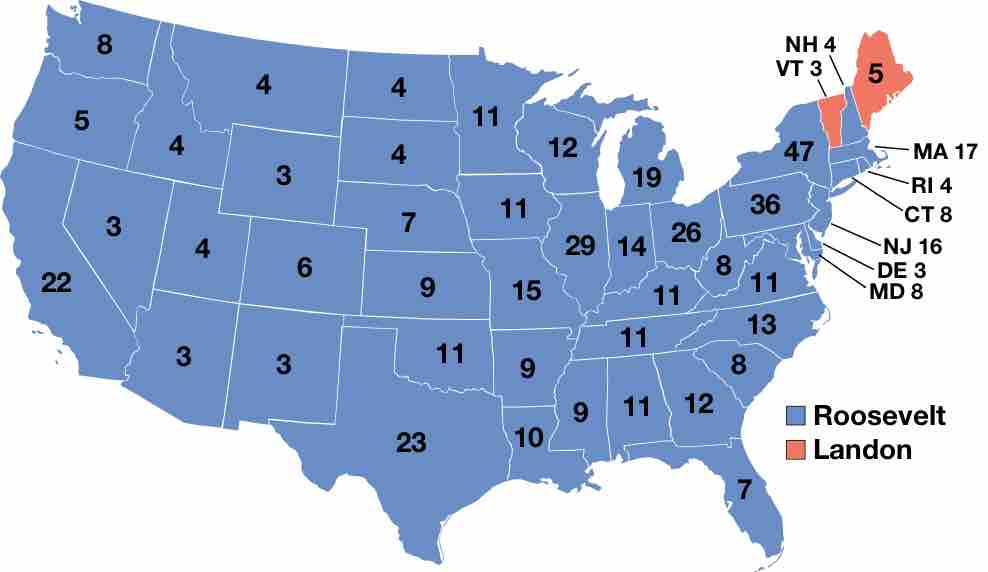The presidential election of 1936 between Franklin D. Roosevelt and Alfred Landon of Kansas was the most lopsided presidential election in U.S. history in terms of electoral votes. In terms of the popular vote, it remained the biggest victory until Lyndon Johnson received more popular votes in 1964 (since the popular vote began to be recorded in 1824). Although some predicted a close race, Roosevelt won the greatest electoral landslide, winning all but eight electoral votes and carrying every state except Maine and Vermont (George Washington in 1789 and 1792 and James Monroe in 1820 won a higher percentage of electoral votes but those were the only cases in U.S. electoral history when candidates run unopposed).
REPUBLICAN PARTY NOMINATION
At the 1936 Republican National Convention (held in Cleveland, Ohio), many candidates sought the Republican nomination but Kansas Governor Alfred “Alf” Landon and Iowa Senator William E. Borah were considered the most serious candidates. The 70-year-old Borah, a well-known member of the progressive wing of the Republican Party, won or performed strongly in a number of primaries. However, the party machinery almost uniformly backed Landon, a wealthy businessman and centrist, who won primaries in Massachusetts and New Jersey and dominated in the caucuses and at state party conventions. Landon won the nomination. His vice presidential candidate was William Franklin Knox, a newspaper editor and publisher from Illinois, who was also one of the minor candidates for the presidential nomination,
DEMOCRATIC PARTY NOMINATION
Incumbent Roosevelt and his vice president, John Nance Garner, had no serious opponents. Henry Skillman Breckinridge, an anti-New Deal lawyer from New York, challenged Roosevelt in four primaries and lost by wide margins. Overall, Roosevelt received 93% of the primary vote, compared to 2% for Breckinridge. At the Democratic Party Convention in Philadelphia, the delegates unanimously re-nominated the incumbents.
OTHER CANDIDATES
Many people expected Huey Long, a very popular Democratic senator from Louisiana, to run as a third-party candidate with his populist "Share Our Wealth" program as his platform. However, Long was assassinated in September 1935. Congressman William Lemke (R-North Dakota) ran as the candidate of the newly-created populist Union Party and Earl Browder represented the Communist Party. None of the third party candidates received substantial support.
CAMPAIGN
Despite the eventual landslide results, the outcome of the 1936 election did not seem certain in the months prior to the election. The Literary Digest, a publication that had correctly predicted the winner of the previous five elections, announced in its October 31 issue that Landon would be the winner with 370 electoral votes. Historians have debated the reason for the error, citing various factors as possible explanations, including biased sample (mostly Republican readers), low response rate, or exclusion of the poor from the survey (most of whom supported Roosevelt in 1936). The mistake was so devastating to the magazine's credibility that it went out of business a few months after the election. In response to the Literary Digest's poll, George Gallup, an American pioneer of survey sampling techniques, conducted and published his own surveys. He predicted both Roosevelt's victory (although his survey's results did not correctly predict the scale of Roosevelt's victory) and that the Digest's results were wrong. His correct predictions made public opinion polling a critical element of elections for journalists and politicians and the Gallup Poll would become a staple of future presidential elections,
RESULTS
Roosevelt won by a landslide, carrying 46 of the 48 states, all but Maine and Vermont, and bringing in additional Democratic members of Congress. He received 60.8% of the popular vote and 523 electoral votes. In response to Roosevelt's victory, the Democratic Party chairman James Farley, who had declared during the campaign that FDR was to lose only those two states, amended the then-conventional political wisdom of "As Maine goes, so goes the nation" into "As goes Maine, so goes Vermont."
Roosevelt's victory was largely driven by the urban working class and the poor who overwhelmingly supported the Democratic candidate. The New Deal Coalition, initiated in 1932, solidified during the 1936 election, attracting one new critical voting bloc and even higher numbers of voters from the blocs formed four year earlier. The white urban working class, more recent European immigrants and their descendants, organized labor, white farmers, and white Southerners were now joined by African Americans, who for the first time in history shifted their political loyalty from Lincoln's party to Democrats. The New Deal's focus on providing relief and reforms that would benefit the poor and working Americans resulted in Roosevelt's extreme popularity among those groups of voters who had historically had very limited political power. Historians also note that the President's use of radio as a medium to explain and popularize his actions cannot be ignored when explaining this wide popular support. The 1936 election proved that the idea of the government's unprecedented intervention in the economy was much more appealing during the time of the economic crisis than the slogans of small government and free market.
Although after the 1936 election some political pundits predicted the virtual extinction of the Republican Party, Republicans would make a strong comeback in the 1938 midterm congressional elections. Despite the 1936 loss in congressional elections and historically low numbers of Republican Representatives and Senators, they remained a potent force in Congress. However, they were not able to win the presidency again until 1952.

1936 Electoral Map
The electoral results of the 1936 presidential election.